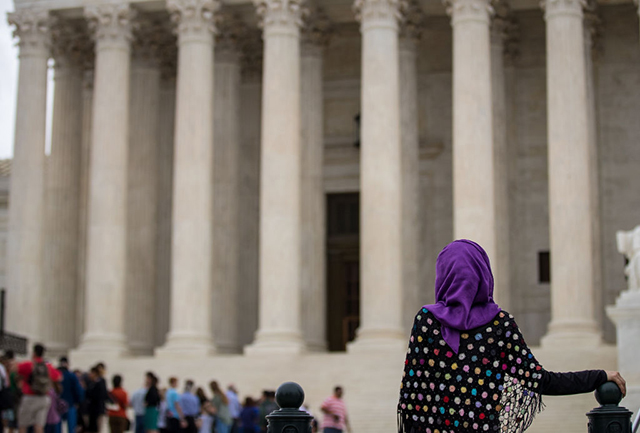
Two days before Trump officially recognized illegally occupied Jerusalem as the capital of Israel and five days after he retweeted a string of false, anti-Muslim videos from the deputy leader of British white supremacist group Britain First, the US Supreme Court ruled that Trump’s Muslim ban does not unfairly discriminate against Muslims and should be fully enforced. The small but significant exemptions from the ban that lower courts had allowed — such as for those with “bone fide” relationships to US institutions or grandparents and cousins — are now no longer valid.
The ruling reminds us that anti-Muslim racism is systemic.
Supporters of the ban argue that the ban does not singularly target Muslims, as the addition of Venezuela and North Korea to the list of six Muslim-majority countries underlines its goal of “national security” rather than Trump’s obsession with what he regularly labels a “Muslim problem.” Solicitor General Noel Francisco, for example, notes that “… these differences confirm that the Proclamation is based on national-security and foreign-affairs objectives, not religious animus.” But history would disagree: Notwithstanding that “protecting national security” and establishing anti-Muslim policies have become virtually synonymous, such policies and the “war on terror” framework itself are regularly expanded to target other communities of color.
Acknowledging that the ban is still a Muslim ban, what can be learned from this Supreme Court decision?
Most clearly, the ruling reminds us that Islamophobia, or, more accurately, anti-Muslim racism, is systemic. Created, upheld and enforced by the state, the Muslim ban has emboldened Customs and Border Protections officers, validated anti-Muslim violence and added to a further loss of already minimal feelings of safety for Muslims across the country.
The Supreme Court maintains a history of institutionalizing, legitimizing and normalizing racism.
In practical terms, this means that symbolic gestures like wearing Hijabs for a day in solidarity, fast-fashion brands’ attempts at surface-level representation, visionless interfaith work and campaigns to “humanize” Muslims aren’t going to cut it. These inadequate steps address anti-Muslim racism as simply “individual bias” that necessitates little more than “love over hate” to solve. This oversimplification of the internationally funded anti-Muslim machine, which is driven by both profit and ideology, allows for simplified understandings of solidarity and organizing. It allows people to pretend that police militarization is not intimately tied to the “war on terror” framework, that Trump is unique in being a racist head of state, and that the ban does not have historical precedent. Moreover, it allows for the belief that the same systems that enact anti-Muslim violence (such as the police, military industry and Countering Violence Extremism programs) can be primary actors in its alleviation.
For Muslims, challenging the ban means moving beyond a reliance on institutions for liberation.
Rather, if the Supreme Court’s decision teaches us anything, it is that we cannot rely on the systems that oppress us to free us. In fact, the decision follows a long legacy of racist and oppressive Supreme Court decisions, including the 1857 Dred Scott v. Sandford case enforcing slavery and excluding African Americans from the Bill of Rights, the 1883 Pace v. Alabama case upholding state laws criminalizing interracial marriage, the infamous “separate but equal” ruling in Plessy v. Ferguson in 1896, and the more recent rulings in the mid-20th century backing Executive Order 9066, which created internment camps for over 120,000 Japanese Americans. The Supreme Court maintains a history of institutionalizing, legitimizing and normalizing racism.
For Muslims, this serves as yet another reminder that assimilation is not a liberation strategy when the system one is being assimilated into is white supremacy.
Challenging the ban means challenging the attempted establishment of new norms of violence, and moving beyond a reliance on institutions for liberation. Understanding the legacies of systemic discrimination upon which such executive orders and Supreme Court rulings are built — and will continue to be built — is integral for developing a strategy to truly move forward.
Our most important fundraising appeal of the year
December is the most critical time of year for Truthout, because our nonprofit news is funded almost entirely by individual donations from readers like you. So before you navigate away, we ask that you take just a second to support Truthout with a tax-deductible donation.
This year is a little different. We are up against a far-reaching, wide-scale attack on press freedom coming from the Trump administration. 2025 was a year of frightening censorship, news industry corporate consolidation, and worsening financial conditions for progressive nonprofits across the board.
We can only resist Trump’s agenda by cultivating a strong base of support. The right-wing mediasphere is funded comfortably by billionaire owners and venture capitalist philanthropists. At Truthout, we have you.
We’ve set an ambitious target for our year-end campaign — a goal of $112,000 to keep up our fight against authoritarianism in 2026. Please take a meaningful action in this fight: make a one-time or monthly donation to Truthout before December 31. If you have the means, please dig deep.